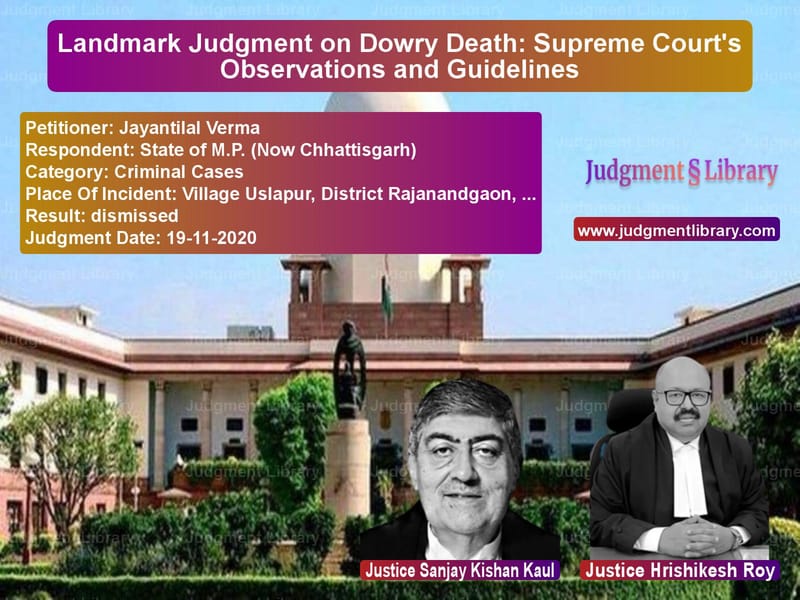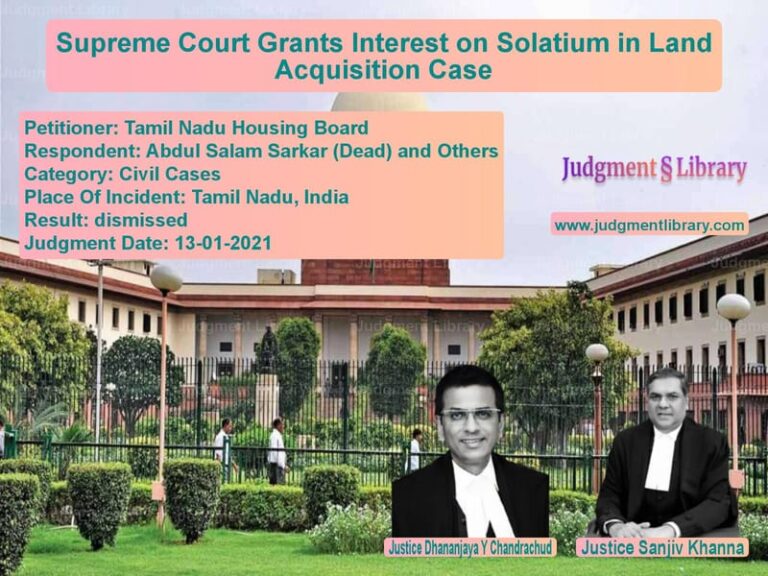Landmark Judgment on Dowry Death: Supreme Court’s Observations and Guidelines
The Supreme Court of India delivered a significant judgment in the case of Jayantilal Verma v. State of M.P. (Now Chhattisgarh), addressing the complexities surrounding the prosecution of dowry death and domestic violence cases. This case revolved around the mysterious death of Sahodara Bai, who was found dead in her matrimonial home under suspicious circumstances. The apex court meticulously examined the circumstantial evidence and the role of the accused while reaffirming the principles of burden of proof under Section 106 of the Indian Evidence Act, 1872.
This case underscores the importance of addressing domestic violence and ensuring justice for victims who suffer in silence. Through this judgment, the Supreme Court has reinforced the legal standards for evidence evaluation in cases involving unnatural deaths within a matrimonial home.
Background of the Case
The tragic incident occurred on August 24, 1999, when Sahodara Bai was found dead on a cot in her matrimonial home in village Uslapur, District Rajanandgaon, Madhya Pradesh (now Chhattisgarh). The case was brought to light by her brother, Kishore Kumar, who had visited the village and was informed of her sudden demise by her in-laws. Prior to her death, the deceased had complained to her family about persistent harassment at the hands of her in-laws. She had visited her maternal home on August 19, 1999, revealing that she had been subjected to mental and physical torture for the past six to seven months. One of the alleged causes of harassment was that her in-laws disapproved of her interacting with the wife of the appellant’s brother.
Despite an attempt at reconciliation by her brothers, Sahodara Bai returned to her matrimonial home. Unfortunately, within days, she was found dead under mysterious circumstances.
Legal Proceedings
Following the discovery of her death, an FIR was registered under Sections 302 read with 34 of the Indian Penal Code (IPC) against her husband (the appellant), father-in-law, and mother-in-law. The post-mortem report confirmed that the cause of death was asphyxia due to strangulation, pointing to a possible homicidal nature of death.
The case proceeded to trial, where the Sessions Court convicted all three accused. The High Court, however, acquitted the mother-in-law but upheld the conviction of the appellant-husband. Dissatisfied with the verdict, the appellant moved the Supreme Court.
Petitioner’s (Appellant’s) Arguments
The appellant’s counsel argued that the evidence presented was purely circumstantial and insufficient to establish guilt beyond a reasonable doubt. The key contentions included:
- The absence of a clear motive for the crime.
- The prosecution’s failure to prove prior allegations of cruelty or harassment, as no formal complaint had been lodged by the deceased or her family.
- The credibility of the prosecution’s main witness (PW-1), who was the stepbrother of the deceased and not her real brother.
- The delay of five days in recording witness statements, raising doubts about the reliability of the testimony.
- The absence of direct evidence linking the accused to the crime.
- The post-mortem report’s inconclusive nature, which only suggested that the death ‘may’ have been homicidal.
- The fact that the mother-in-law was acquitted based on the same evidence, which should have benefited the appellant as well.
Respondent’s (State’s) Arguments
The State defended the conviction, relying on the following points:
- The lack of a proper explanation from the accused regarding the cause of death, despite it occurring within the confines of the matrimonial home.
- The obligation under Section 106 of the Indian Evidence Act, 1872, which shifts the burden of proof to the accused when a crime occurs within their exclusive knowledge.
- The testimony of PW-1, which consistently pointed to the history of harassment and the strained relationship between the deceased and her in-laws.
- The medical evidence, which clearly indicated strangulation marks and signs of physical struggle, ruling out accidental or natural causes of death.
Key Observations by the Supreme Court
1. Burden of Proof and Section 106 of the Indian Evidence Act
The Court emphasized that when an unnatural death occurs in a household where only family members reside, the burden of proof shifts to the accused to provide a plausible explanation for the incident. The judgment referred to several precedents, including Trimukh Maroti Kirkan v. State of Maharashtra, to highlight that in cases of domestic homicide, the accused cannot remain silent and must offer a valid defense.
2. Role of Circumstantial Evidence
The Supreme Court reiterated that circumstantial evidence could form the basis of conviction if it established a complete chain of events leading to the guilt of the accused. The evidence in this case included:
- The history of harassment and cruelty.
- The deceased’s prior complaint to her family.
- The forensic findings confirming strangulation.
- The accused’s failure to provide a reasonable explanation for the death.
3. Credibility of Witnesses
Although several witnesses turned hostile, the Court upheld the testimony of PW-1, stating that his account was consistent and supported by medical evidence. The judgment also referred to Yanob Sheikh Alias Gagu v. State of West Bengal, which emphasized that the quality of evidence matters more than the number of witnesses.
4. Acquittal of the Mother-in-law
The Supreme Court clarified that the mother-in-law’s acquittal was based on the lack of direct involvement, whereas the husband, being the primary resident of the household, bore the primary responsibility for explaining his wife’s death.
5. Sentencing Considerations
The appellant had already served over 16 years of his sentence. The Court directed the State to consider his case for release if he had completed 14 years of actual imprisonment.
Conclusion
This judgment reinforces the principle that in cases of unnatural death within a matrimonial home, the onus of providing a reasonable explanation falls on the accused. The Supreme Court’s ruling serves as a significant precedent in ensuring justice for victims of domestic violence and dowry-related deaths. By emphasizing the importance of circumstantial evidence and the role of burden shifting under Section 106 of the Indian Evidence Act, the Court has strengthened legal safeguards for vulnerable individuals.
The ruling not only upholds justice for the deceased but also serves as a cautionary message against domestic violence and dowry harassment. The case highlights the critical need for social awareness and stringent legal enforcement to prevent such tragedies in the future.
Petitioner Name: Jayantilal Verma.Respondent Name: State of M.P. (Now Chhattisgarh).Judgment By: Justice Sanjay Kishan Kaul, Justice Hrishikesh Roy.Place Of Incident: Village Uslapur, District Rajanandgaon, Chhattisgarh.Judgment Date: 19-11-2020.
Don’t miss out on the full details! Download the complete judgment in PDF format below and gain valuable insights instantly!
Download Judgment: Jayantilal Verma vs State of M.P. (Now C Supreme Court of India Judgment Dated 19-11-2020.pdf
Direct Downlaod Judgment: Direct downlaod this Judgment
See all petitions in Murder Cases
See all petitions in Domestic Violence
See all petitions in Custodial Deaths and Police Misconduct
See all petitions in Judgment by Sanjay Kishan Kaul
See all petitions in Judgment by Hrishikesh Roy
See all petitions in dismissed
See all petitions in supreme court of India judgments November 2020
See all petitions in 2020 judgments
See all posts in Criminal Cases Category
See all allowed petitions in Criminal Cases Category
See all Dismissed petitions in Criminal Cases Category
See all partially allowed petitions in Criminal Cases Category







